Why Do Uranus and Neptune Appear Blue?
Samantha Lundquist, Jeff Chmarney, Steven Rogers, Miranda Halladay, and Lauren Wakelam
Remarkable Blue Colours – What are we looking at?
Neptune and Uranus, two of the Jovian planets in our solar system, are known for their remarkable blue colours. Since their discoveries, the cause of their mysterious blue atmospheres has been questioned by many scientists and astronomers. Quite recently, it has been discovered that the cause for this colouration is due to the presence of low methane concentrations in each of the planet’s atmospheres.
Using data acquired from various spectrometer readings, scientists have concluded that Neptune and Uranus’ atmospheric compositions are quite similar, regardless of their differing sizes and positions in the solar system. Our aim is to gain a deeper understanding as to why the planets are blue, as well as to understand the different technologies, and methods utilized by scientists to reach these results.
Brief Overview of the Planets
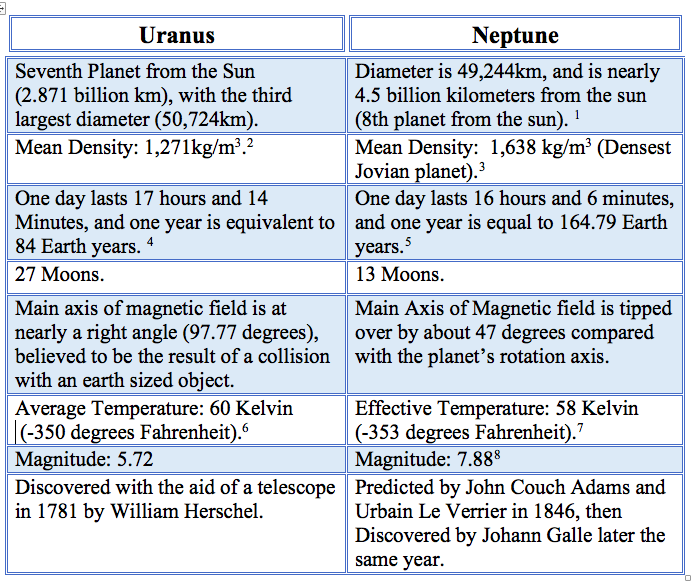
Table showing basic facts that outline the differences and similarities between Neptune and Uranus. Many similarities exist because both planets are Jovian ice giants. They were also the first two planets to actually be discovered, as they are not (or barely) visible to the human eye on earth.
Physics 101 – The Science of Spectroscopy
In the early part of the 20th century, discoveries made on the nature of light gave astronomers a new tool (spectroscopy) to determine the chemical compositions of the atmospheres of the planets. With this new tool, ground based astronomy was able to determine why the colour of the Uranus and Neptune appear to us as blue.[7]
![Figure 1. Electromagnetic Wave By P.wormer (Own work) [CC BY-SA 3.0 (http://creativecommons.org/licenses/by-sa/3.0) or GFDL (http://www.gnu.org/copyleft/fdl.html)], via Wikimedia Commons https://commons.wikimedia.org/wiki/File:Electromagnetic_wave.png](https://sites.usask.ca/astr104/wp-content/uploads/sites/14/2016/09/Electromagnetic_wave.png)
Figure 3. Electromagnetic Wave. By P.wormer (Own work) [CC BY-SA 3.0 (http://creativecommons.org/licenses/by-sa/3.0) or GFDL (http://www.gnu.org/copyleft/fdl.html)], via Wikimedia Commons https://commons.wikimedia.org/wiki/File:Electromagnetic_wave.png.
The light that we see when we look at any of the planets in our solar system originates from the sun. Light travels from the sun towards the planets as an electromagnetic wave traveling through space (Figure 3).

Figure 4. Photon Emission. By JabberWok at the English language Wikipedia, CC BY-SA 3.0, https://commons.wikimedia.org/w/index.php?curid=2639910.
This electromagnetic wave then interacts with the atoms in the atmosphere of the planets. Certain frequencies of this electromagnetic wave are absorbed by the atoms and causing the electrons in the atom to vibrate to higher energy levels. When these electrons return to a lower energy level within the atom, they emit photons at a frequency proportional to the change in energy (Figure 4).
These photons are then free to travel as electromagnetic radiation in all directions. The final result is that the light we observe (when we look at a planet from Earth) is light which originated from the sun, which then traveled to the planets and was scattered/reflected, absorbed or transformed by the atoms in the planet’s atmosphere. The fraction of electromagnetic radiation that an object reflects is called the Albedo. As this scattered/reflected, absorbed or transformed light from planets reaches the Earth, it must also travel through our atmosphere to reach our telescopes. As the light travels through our atmosphere, it then interacts again with the atoms that make up our atmosphere. Because of this, we observe only certain frequencies of light (primarily the visible and radio wave frequencies ) here on Earth because our atmosphere and magnetosphere scatters/reflects, absorbs or transforms most of the incoming electromagnetic radiation. Our atmosphere is mostly transparent at visible light and radio frequencies, but opaque for many of the other frequencies (Figure 5. Frequency=1/Wavelength).

Figure 5. Wavelengths that can be seen on Earth. By NASA (original); SVG by Mysid. [Public domain], via Wikimedia Commons. https://commons.wikimedia.org/wiki/File%3AAtmospheric_electromagnetic_opacity.svg.
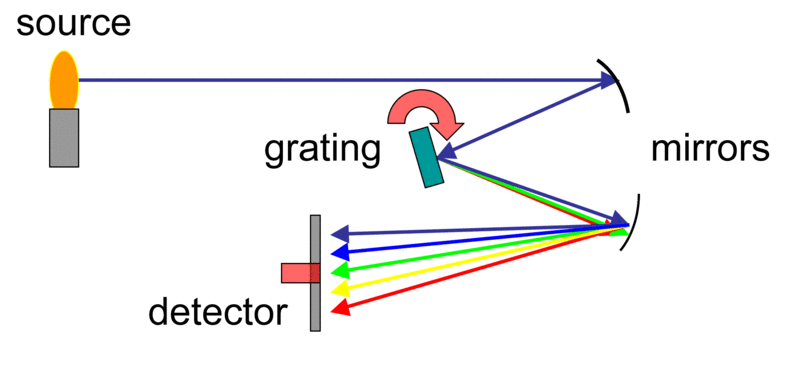
Figure 6. Spectrograph. By Kkmurray – Own work, CC BY-SA 3.0, https://commons.wikimedia.org/w/index.php?curid=2790976.
By analyzing the frequencies of light that we see when we look at an object like a planet using a Spectrograph, we can determine the chemical compounds present in it’s atmosphere by comparing the frequency components of light that we see with known characteristic frequencies of gases that we obtain experimentally here on earth.
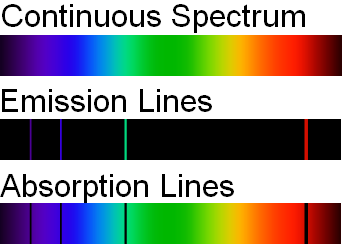
Figure 7. Types of Spectra. By User:Jhausauer – Author, Public Domain, https://commons.wikimedia.org/w/index.php?curid=13358404.
White light (light of all frequencies) displays a continuous spectra (all visible colors) when viewed through a Spectrograph. A hot gas displays discrete spectral lines called emission lines at certain characteristic frequencies based on the type of elements that the gas is composed of. White light that travels through a gas, interacts with that gas removing certain frequencies (absorption). These absorbed frequencies produce characteristic dark absorption lines in the continuous spectra which help to identify elements within the gas (Figure 7).

Figure 8. Visual spectrum of the Sun when viewed through a Spectrograph. By: https://en.wikipedia.org/wiki/Absorption_spectroscopy.
Characteristic absorption lines are seen when we look at the sun as there are atmospheric elements just outside of the sun (called the Photosphere) as well as elements within Earth’s atmosphere that absorb certain frequencies of light (Figure 8).
The relatively new (within the last century) science of spectroscopy has enabled us to determine chemical compositions of the atmosphere of the planets. By comparing the absorption and emission spectra of chemical elements here on Earth with spectroscopic observations of the planets, we are able to to determine why Uranus and Neptune appear to us to be blue. Spectral analysis has shown that these planets contain trace amounts of methane, a gas that readily absorbs the red spectral components of light..[8] Because of this, most of the light in the red frequency range is absorbed by the atmosphere while most of the light in the blue frequency range is scattered. The white clouds that we observe on Neptune appear because white light from the sun does not have to travel very far into Neptune’s atmosphere before interacting with Methane Ice crystals which readily reflect the sun’s white light back out into space towards us.[9] It is interesting to note that despite having similar atmospheric compositions, (such as the levels of methane in their atmospheres) the bluish colours of Uranus and Neptune tend to differ substantially..[10] Future studies of these planets atmospheres using the James Webb Space Telescope, hope to uncover some of the reasons for these observed differences..[11]
Past and Present Tools of Atmospheric Analysis

Figure 9. Ground Based Astronomical Spectroscopy. By Julius Scheiner – http://books.google.com/books?id=f040AQAAMAAJ&ots=_zupZ0Gr_q&lr&pg=PA74#v=onepage&q&f=false, Public Domain, https://commons.wikimedia.org/w/index.php?curid=28974748.
Before the Space Age, (that occurred in the later part of the 1950’s) the only method available to study the atmospheres of Uranus and Neptune was using ground based technologies located here on Earth (Figure 9). As was discussed in the previous section, the light that we see here on earth interacts with the elements in our atmosphere before reaching our telescopes. Because of this, Earth’s atmosphere had to be taken into account when analyzing spectral data from other planets using telescopes on our planets surface.
The start of the space age allowed previous and new ground based technologies that were developed to be moved outside of our atmosphere, avoiding Earth’s atmospheric interference effects on incoming light.
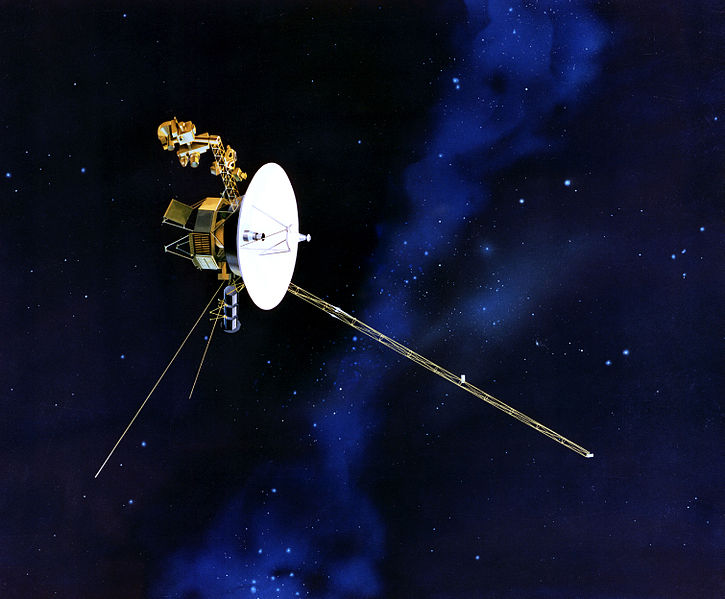
Figure 10. Voyager 2 Space Probe. By NASA/JPL [Public domain], via Wikimedia Commons. https://commons.wikimedia.org/wiki/File%3AVoyager_spacecraft.jpg.
There were many different types of instruments included with this probe which helped to analyze the various atmospheric characteristics of the planets during the probes observational phase of Uranus in 1985 and Neptune in 1989. Two particular instruments related to spectroscopy are the Infrared Interferometer Spectrometer (IRIS) and the Ultraviolet Spectrometer (UVS)..[12]
IRIS objectives included, determination of atmospheric thermal vertical structure, measurement of abundance of hydrogen and helium, and determination of the balance of energy radiated to that absorbed from the sun. UVS objectives included, determination of scattering properties of the lower planetary atmospheres and determination of the distributions of constituents with height. The wide array of instruments, which included the IRIS and UVS spectrometers, gave astronomers at that time an unprecedented picture of the makeup of each of these planet’s atmospheres. With Voyager 2, bright and dark contrast, strong winds, high altitude clouds of each planet’s atmosphere could be further resolved and analyzed.[13]
The Hubble Space telescope which was launched in 1990, included six science instruments (Figure 11).[14]

Figure 11. Hubble Space Telescope: Space Telescope Imaging Spectrograph (STIS). By NASA/STScI – http://hubblesite.org/newscenter/newsdesk/archive/releases/1998/41/image/r, Public Domain, https://commons.wikimedia.org/w/index.php?curid=4598666.
Three of which (related to spectroscopy) include the Cosmic Origins Spectrograph (COS), the Near Infrared camera and Multi-object Spectrometer (NICMOS) and Space Telescope Imaging Spectrometer (STIS). COS focuses specifically on ultraviolet light frequencies and is used to determine an object’s temperature, density, velocity and chemical composition. NICMOS analyzes the near infrared frequencies of light and STIS analyses frequencies ranging from ultraviolet, to visible, to infrared. The inclusion of these various types of spectrographs on the Hubble Space telescope has greatly improved our ability to study the outer planets from Hubble’s low earth orbit. A breakdown of some of the things we have learned about the atmospheres of Uranus and Neptune (using some of the tools above) is given in the following section.
Breakdown of the Atmospheric Composition
Neptune
Neptune’s atmosphere primarily consists of hydrogen and helium which makes up about 99% of the entire atmospheric composition. Methane consists part of that 1% left which, according to spectroscopy and infrared scanning, contributes to the blue color that is being observed by researchers.[15] Based on the previous studies that have been conducted with spectroscopy it was determined that the most likely reason that Neptune, as well as Uranus, are blue is because methane reflects the blue photons while absorbing the rest of the photons on the spectrum. Through the use of ultraviolet scanning it can be seen that the planet also has internal heating system that allows the planet to have a higher temperature than what it should, since the distance between it and the sun is 4.5bil km.[16] Also though the use of ultraviolet spectrometry it was shown that the planet contains a mixture of both ice/liquid water which could attribute to the specific photons that are being absorbed by the atmosphere contributing to the deep blue color being observed, considering that Uranus does not have these oceans. Neptune is shown to have highly dense gases near its core that start to form a liquid metallic like core, which is then surrounded by liquid water oceans; this is demonstrated through the use of ultraviolet scanning of the planet by the Voyager 2.[17]

Figure 12. Ultraviolet Images of Neptune. Credit: E. Karkoschka/The University of Arizona
Uranus

Figure 13. Composition of Uranus. Diagram showing the composition of Uranus. Courtesy of Famdon [Public Domain]. http://galnet.wikia.com/wiki/File:1-uranus.png
Compare and Contrast Uranus and Neptune Compositions

Figure 14. Molecular Composition of Jupiter, Saturn, Uranus and Neptune. Courtesy of NASA [Public Domain].

Figure 15. Comparison of the specra of Uranus and Neptune. Copyright 2016 ZEDS Astronomical Observatory.
Due to their small size their atmospheric compositions both consist of heavier metals, like ammonia and methane, than the larger gas planet’s.[21] It has been believed that the colour difference between these two planets is contributed to the distance from the sun; where the sunlight that is reflected within the atmosphere might play a major role in what colours are being observed from Earth. It is believed, through the use of spectrometry, that the sunlight is being reflected more readily in the atmosphere of Uranus; the photons from the blue-green side of the spectrum are being reflected while the photons from the red side of the spectrum are being absorbed. This is because the planets density is very low which can play an important role in reflecting light off of the atmosphere. While Neptune also reflects the same photons of light however it has a deeper blue reflection than Uranus and it is hypothesized that the difference might be due to the liquid water that is on the surface of Neptune which could influence the color absorption of the sunlight.[22] It is important to note that there is still no scientific evidence suggesting why these planets have such a drastic difference in coloring.
To Be Discovered…
There are still many questions about Neptune and Uranus that remain unanswered. Over the last century advancements in astronomical technologies, specifically spectroscopy, have brought us closer to understanding the atmosphere composition and colouration of Uranus and Neptune. Despite observations from the Voyager 2 mission and the Hubble Space Telescope, much still remains unknown to researchers about these planets and their colouration. One question that remains unanswered is; why despite having similar atmospheric compositions, such as the percent of methane in the atmosphere, does the blueish colour differ so much between the two planets?
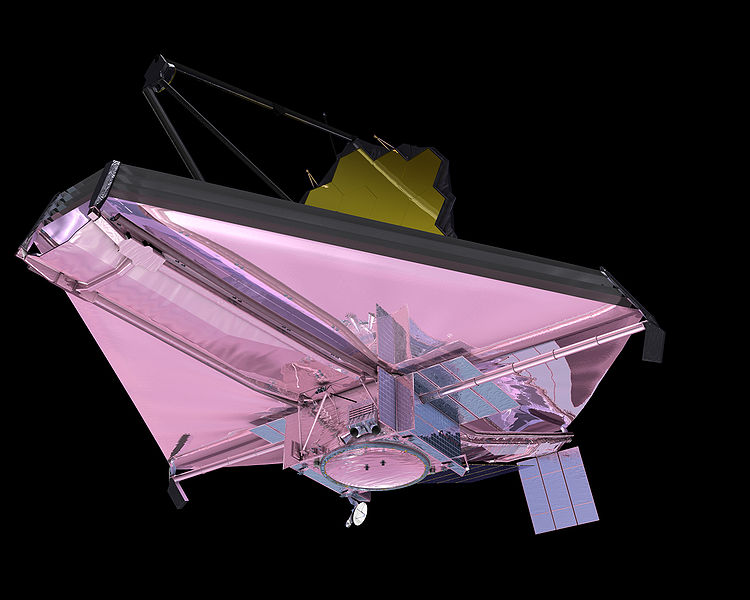
Figure 16. Image of the James Webb Telescope, by NASA [Public Domain], via Wikimedia Commons.
Summary
Since their discovery, astronomers have questioned why both Uranus and Neptune have a blue colouration. One of the main methods in determining this is through atmospheric composition analysis, using the tools of spectroscopy. It has been discovered that methane is present in low concentrations, in both atmospheres. Methane readily absorbs red frequencies of light, while the atmospheres scatter blue frequencies, therefore the two planets are observed to be blue. Although the reasoning behind the bluish colours of the two atmospheres has been established, much is still unknown. Despite the similar atmospheric compositions, such as the percentage of methane in the atmospheres, the bluish color differs substantially between the two planets. Some of the current research continues to be geared towards this question, as there is still much to be discovered.
“I seem to have been only like a boy playing on the seashore, and diverting myself in now and then finding a smoother pebble or a prettier shell than ordinary, whilst the great ocean of truth lay all undiscovered before me.” – Isaac Newton.
Reference Material
[1] NASA, Neptune in Depth, (https://solarsystem.nasa.gov/planets/neptune/indepth).
[2] NASA, Uranus: In Depth, (http://solarsystem.nasa.gov/planets/uranus/indepth).
[3] F. Cain, How Long is a Year on Neptune, (www.universetoday.com/22064/how-long-is-a-year-on-neptune/).
[4] NASA, The Planet Uranus, (http://voyager.jpl.nasa.gov/science/uranus_planet.html).
[5] NASA, Neptune: By the Numbers, (http://solarsystem.nasa.gov/planets/neptune/facts).
[6] Computer Program Stellarium, Version 0.15, (Free Software Foundation Inc., 2016).
[7] Hubblesite, Hubble Space Telescope Observations of Neptune, (http://hubblesite.org/newscenter/archive/releases/1995/09/image/a/).
[8] Hubblesite, Hubble Space Telescope Observations of Neptune, (http://hubblesite.org/newscenter/archive/releases/1995/09).
[9] Hubblesite, Hubble Space Telescope Observations of Neptune, (http://hubblesite.org/newscenter/archive/releases/1995/09).
[10] J. I. Lunine, Annu. Rev. Astron. Astrophys., 31, 217 (1993).
[11] J. Norwood, et al., Giant Planet Observations with the James Webb Space Telescope, (https://arxiv.org/ftp/arxiv/papers/1510/1510.06205.pdf).
[12] Voyager the Interstellar Mission, (http://voyager.jpl.nasa.gov/spacecraft/instruments.html).
[13] J. I. Lunine, Annu. Rev. Astron. Astrophys., 31, 217 (1993).
[14] Hubblesite, The Science Instruments, (http://hubblesite.org/the_telescope/nuts_.and._bolts/instruments/).
[15, 16, 17] F. Cain, What is Neptune Made of, (http://www.universetoday.com/21596/what-is-neptune-made-of/).
[18, 19] Windows to the Universe, The Composition of Uranus’ Interior, (http://www.windows2universe.org/uranus/interior/U_int_compo_overview.html).
[20] J. I. Lunine, Annu. Rev. Astron. Astrophys., 31, 217 (1993).
[21] E. Howell, Gas Giants: Facts About the Outer Planets, (http://www.space.com/30372-gas-giants.html).
[22] J. Norwood, et al., Giant Planet Observations with the James Webb Space Telescope, (,https://arxiv.org/ftp/arxiv/papers/1510/1510.06205.pdf).
[23, 24] J. Norwood, et al., Giant Planet Observations with the James Webb Space Telescope, (,https://arxiv.org/ftp/arxiv/papers/1510/1510.06205.pdf).
![Neptune. Credit: NASA/JPL [Public Domain].](https://sites.usask.ca/astr104working/wp-content/uploads/sites/31/2016/03/PIA014921-300x300.jpg)
![Uranus. Credit: NASA/JPL-Caltech. [Public Domain].](https://sites.usask.ca/astr104working/wp-content/uploads/sites/31/2016/03/PIA18182-300x300.jpg)